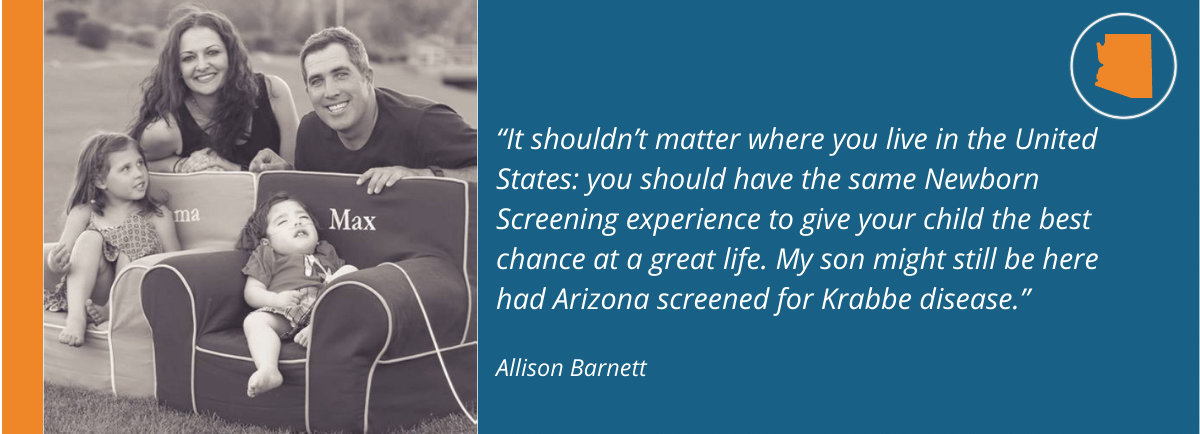DOWNLOAD STATE FACT SHEET AS PDF

In 2020, there were 76,947 live births in Arizona2 There are 33 conditions on the Arizona Newborn Screening Panel3 All babies in the United States are screened for several conditions shortly after birth. Approximately 24-48 hours after a baby is born in the United States, the heel is pricked by a nurse to collect a small sample of blood. Afterwards, the nurse puts a series of blood drops onto a filter paper to create several “dried blood spots.” Next, the newborn screening card is sent to the state laboratory for analysis. House Bill 2388 was introduced in 2014 by way of
grassroots efforts from two families impacted by Krabbe disease, the Stuzman and Gerlitz families. This bill would implement legislation requiring Arizona to add Krabbe disease to the their newborn screening panel. The bill did not pass.
What is Krabbe Disease?
Krabbe disease (pronounced krab A) is a rare genetic disorder known as globoid cell leukodystrophy. In the United States, Krabbe disease has been reported to affect approximately 1 in 100,000 individuals. Infantile Krabbe disease is the most common and severe form causing infants to lose the ability to eat, extreme irritability, inability to sit up, and grasp objects, blindness, and seizures. Sadly, infants die within the first 2-3 years of life in states that do not test for Krabbe disease. We invite you to learn more about Understanding Krabbe Disease.
Why Screen for Krabbe Disease?
Krabbe disease is a severe neurodegenerative and rapidly progressing condition requiring immediate treatment for the most severe forms. Max was diagnosed with an early onset form of Krabbe disease at 6 months of age. This form, known as infantile Krabbe disease requires treatment within the first 30-45 days of life. If Max was identified at birth with Krabbe disease, Max could have undergone a stem cell transplant. Due to his delayed diagnosis palliative and supportive care were he’s only means of treatment.
Krabbe Disease Hero: Max Barnett

See all our Krabbe Disease Heroes.
Max was born on February 6, 2014, to parents Allison and Josiah. He was healthy and such a happy baby, always smiling. At his six-month well-check appointment the doctor noted that he was a little delayed with some milestones. Around eight months of age, they began to notice that Max was struggling to sit up straight, he was a little fussier, he stopped grabbing for things, and he wasn’t rolling. At his nine-month well-check, the pediatrician told them to take him to the emergency room because his breathing had become a little more shallow and something was off. An MRI was performed and they were sent home with no real answers other than he had some vanishing white matter. The pediatrician arranged for Allison and Josiah to meet with a genetics doctor the following week where they did blood work to test for some rare disorders. At the next appointment, the geneticist walked in with two neurologists, and with the worst possible news – Max had a leukodystrophy called Krabbe Disease. The doctors told Allison and Josiah to take Max home and make him comfortable.
Max quickly lost his eyesight but he loved superheroes, music, and his older sister, Emma. He would always look in her direction when she was around. Allison and Josiah created a bucket list for Max and experienced many great things with him.
Newborn Screening would have given the Barnetts an opportunity to have Max treated and to have given him a chance at life.
Resources
- The Leukodystrophy Newborn Screening Action Network is dedicated to advancing newborn screening for leukodystrophies and lysosomal storage disorders, supporting newly-diagnosed families, and ensuring collaboration between all stakeholders. Learn more at https://ldnbs.org/.
- CDC offers funding and assistance through the Newborn Screening Quality Assurance Program (NSQAP). More information can be found at https://www.cdc.gov/labstandards/nsqap.html.
- Baby’s First Test provides funding opportunities through grants. Learn more at https://www.babysfirsttest.org/newborn-screening/funding-opportunities.
- American Public Health Laboratories NewSTEPS program provides data, technical assistance, and training. Details at https://www.newsteps.org/.
- KrabbeConnect offers patient support services to help families navigate the burden of Krabbe disease. Learn more at https://krabbeconnect.org/.
- Hunter’s Hope Foundation is a non-profit organization committed to giving hope through education, awareness, research, and family care for all leukodystrophies. Learn more at https://www.huntershope.org/.
Citations
- Wenger DA. Krabbe Disease. 2000 Jun 19 [Updated 2011 Mar 31]. In: Pagon RA, Adam MP, Ardinger HH, et al., editors. GeneReviews® [Internet]. Seattle (WA): University of Washington, Seattle; 1993-2017.
- “Fertility Rate: Arizona, 2010-2020.” March of Dimes | PeriStats, https://www.marchofdimes.org/peristats/data?reg=99&top=2&stop=1&lev=1&slev=4&obj=1&sreg=04&creg. Accessed 22 Sep. 2022.
- “Arizona | Baby’s First Test | Newborn Screening | Baby Health.” Babysfirsttest.org, 2015, https://www.babysfirsttest.org/newborn-screening/states/arizona. Accessed 22 Sept. 2022.
All information in this fact sheet is based on data available before September 9, 2022.


